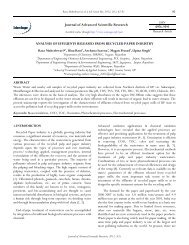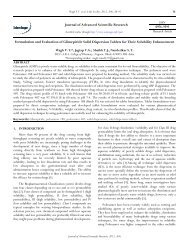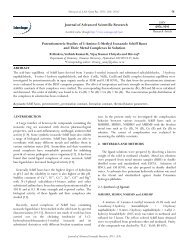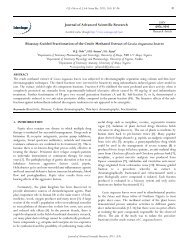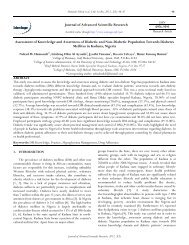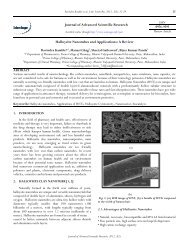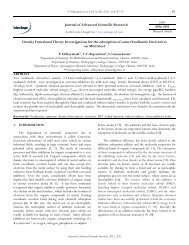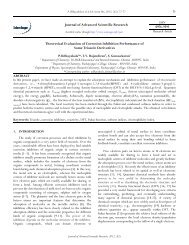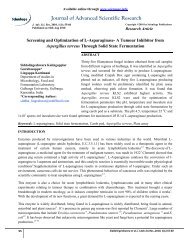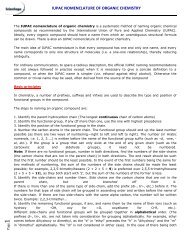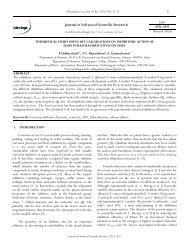Development and Characterization of ... - Sciensage.info
Development and Characterization of ... - Sciensage.info
Development and Characterization of ... - Sciensage.info
You also want an ePaper? Increase the reach of your titles
YUMPU automatically turns print PDFs into web optimized ePapers that Google loves.
2.2.11. Fourier Transform Infrared studies<br />
Fourier Transform Infrared (FT-IR) analysis measurements<br />
<strong>of</strong> pure drug, carrier <strong>and</strong> drug-loaded microcapsules<br />
formulations were obtained using a Perkin-Elmer system<br />
200FT-IR spectrophotometer. The pellets were prepared on<br />
KBr-press under a hydraulic pressure <strong>of</strong> 150 kg/cm 2 ; the<br />
spectra were scanned over the wave number range <strong>of</strong> 4000-<br />
400 cm -1 at the ambient temperature.<br />
2.2.12. Differential scanning calorimetry (DSC)<br />
Differential scanning calorimetry (DSC) was performed on<br />
nateglinide drug loaded microcapsules using Seiko (Japan) DSC<br />
model 220C. Samples were sealed in aluminum pans <strong>and</strong> the<br />
DSC thermograms were reported at a heating rate <strong>of</strong><br />
10°C/min from 20 to 260°C.<br />
2.2.13. X-ray diffraction studies<br />
Different samples were evaluated by X-ray powder<br />
diffraction. Diffraction patterns were obtained using X-ray<br />
diffractometer with a radius <strong>of</strong> 240 mm. The Cu Ka radiation<br />
was Ni filtered. A system <strong>of</strong> diverging <strong>and</strong> receiving slits <strong>of</strong> 1<br />
<strong>and</strong> 0.1mm respectively was used. The pattern was collected<br />
with 40 kV <strong>of</strong> tube voltage <strong>and</strong> 30 mA <strong>of</strong> tube current <strong>and</strong><br />
scanned over the 2Ѳ range <strong>of</strong> 10 0 -80 0 .<br />
2.2.14. In vitro wash-<strong>of</strong>f test for mucoadhesive microcapsules<br />
The mucoadhesive property <strong>of</strong> the microcapsules was<br />
evaluated by an in vitro adhesion testing method known as<br />
wash-<strong>of</strong>f method. A piece <strong>of</strong> goat intestinal mucus (2 × 2 cm)<br />
was mounted onto glass slides <strong>of</strong> (3 × 1 inch) with elastic<br />
b<strong>and</strong>s. Glass slide was connected with a suitable support.<br />
About 50 microcapsules were spread onto each wet tissue<br />
specimen, <strong>and</strong> thereafter the support was hung onto the arm <strong>of</strong><br />
a USP tablet disintegrating test machine (Electro Lab, ED<br />
2AL). The disintegration machine containing tissue specimen<br />
was adjusted for a slow, regular up <strong>and</strong> down moment in a test<br />
fluid at 37 o C taken in a beaker. At the end <strong>of</strong> 1 h <strong>and</strong> later at<br />
hourly intervals up to 8 hours, the machine was stopped <strong>and</strong><br />
the number <strong>of</strong> microcapsules still adhering onto the tissue was<br />
counted. The test was performed in phosphate buffer <strong>of</strong> pH 6.8<br />
[20].<br />
Santhosh Kumar Mankala et al, J Adv Scient Res, 2011; 2(4): 34-45 38<br />
tied in a muslin bag <strong>and</strong> kept in the basket. Five milliliter<br />
samples <strong>of</strong> the dissolution fluid were withdrawn at regular<br />
intervals <strong>and</strong> replaced with fresh quantity <strong>of</strong> dissolution fluid.<br />
The samples were filtered, diluted <strong>and</strong> analyzed, using Elico,<br />
SL-158 Double-beam UV-Visible Spectrophotometer at<br />
wavelength 221 <strong>and</strong> 227 nm respectively. For all the<br />
formulations, the dissolution was carried out in triplicates <strong>and</strong><br />
statistically analyzed using InStat3®. The obtained data were<br />
used to calculate the % drug release <strong>and</strong> to determine the<br />
order <strong>and</strong> mechanism <strong>of</strong> the release [21]. The formulation that<br />
showed best release was prepared 6 times <strong>and</strong> 3 samples from<br />
each batch were evaluated for drug release <strong>and</strong> the results were<br />
statistically analyzed by analysis <strong>of</strong> variance (one factor<br />
ANOVA) [22].<br />
2.2.16. Curve fitting analysis [23-26]<br />
Zero-order release rate kinetics<br />
To study the zero–order release kinetics, the release rate<br />
data are fitted to the following equation:<br />
Q<br />
0<br />
K t …. (12)<br />
where “Q” is the fraction <strong>of</strong> drug released, “K” the release rate<br />
constant <strong>and</strong> “t” is the release time.<br />
First-order kinetics<br />
A first-order release would be predicated by the following<br />
equation:<br />
Kt<br />
LogC LogCo …. (13)<br />
2.303<br />
where; C = amount <strong>of</strong> drug remaining at time “t”, Co = initial<br />
amount <strong>of</strong> the drug <strong>and</strong> K = first-order rate constant (h -1 )<br />
When the data are plotted as cumulative percent drug<br />
remaining versus time, it yields a straight line, indicating that<br />
the release follows first-order kinetics. The constant “K” can be<br />
obtained by multiplying 2.303 with slope.<br />
Higuchi release model<br />
To study the Higuchi release kinetics, the release rate data<br />
were fitted to the following equation:<br />
1/2<br />
Q K.t …. (14)<br />
2.2.15. In vitro drug release studies <strong>of</strong> microcapsules<br />
In vitro drug release studies <strong>of</strong> microcapsules were carried<br />
out using USP XXIII Eight station dissolution rate test<br />
apparatus Type I with a basket stirrer (Electro Lab, EDT 08<br />
LX) at 100 rpm in 900 ml 0.1 N HCl for the 1 st 2 h, then in<br />
phosphate buffer <strong>of</strong> pH 7.4 at 50 rpm <strong>and</strong> temperature 37 +<br />
0.5 o C. Microcapsules equivalent to 100 mg <strong>of</strong> nateglinide were<br />
where, “Q” is the amount <strong>of</strong> drug released, “K” the release rate<br />
constant, <strong>and</strong> “t” is the release time.<br />
When the data are plotted as accumulative drug released versus<br />
square root <strong>of</strong> time, it yields a straight line, indicating that the<br />
drug was released by diffusion mechanism. The slope is equal<br />
to “K”.<br />
Journal <strong>of</strong> Advanced Scientific Research, 2011, 2(4)



